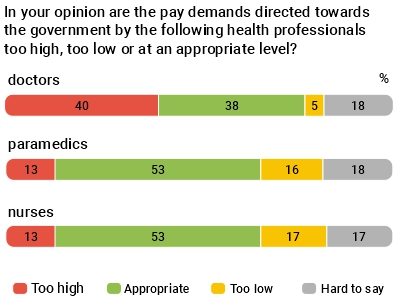35/2021
2021-11-10
The Pay Demands of Protesting Medical Personnel
The countrywide health service workers’ protest began on September 11. The protestors have drawn up eight demands; most discussion has been provoked by the one concerning minimum basic pay rates for the different health service worker groups. In the CBOS October survey, people were asked about their attitudes to the pay demands of selected groups.

|
How Poles perceived the pay demands of health workers varied according to the particular profession of the protestors. Doctors garnered the least approval for their financial expectations, with just about equal percentages of respondents saying they were too high (40%) as said they were appropriate (38%). More than one in six did not know what to think (18%), while very few thought doctors were not demanding enough pay (5%). Perceptions of paramedics’ and nurses’ financial expectations were virtually identical. The majority of those surveyed thought that the pay demands of both these groups were reasonable (53% each). Every sixth respondent said they were too low (17% for nurses, 16% for paramedics), while one in eight said they were too high (13% each). A similar number as for doctors had no opinion either way (17% for nurses, 18% for paramedics.)
More on this subject in the CBOS report.
This ‘Current Events and Problems’ survey (377) was conducted using a mixed-mode procedure on a representative sample of named adult residents of Poland, randomly selected from the National Identity Number (PESEL) register.
Respondents independently selected one of the following methods:
– Computer Assisted Personal Interview (CAPI);
– Computer Assisted Telephone Interview (CATI), respondents receiving researchers’ telephone numbers in an introductory letter from CBOS;
– Computer Assisted Web Interview (CAWI), where respondents filled in the online questionnaire independently, gaining access by means of a login and password provided in an introductory letter from CBOS.
– Computer Assisted Personal Interview (CAPI);
– Computer Assisted Telephone Interview (CATI), respondents receiving researchers’ telephone numbers in an introductory letter from CBOS;
– Computer Assisted Web Interview (CAWI), where respondents filled in the online questionnaire independently, gaining access by means of a login and password provided in an introductory letter from CBOS.
In all three cases the questionnaire had the same structure and comprised the same questions. The survey was carried out between 4 – 14 October 2021 inclusive on a sample of 1161 people (55.2% using the CAPI method, 28.9% CATI and 15.9% CAWI).
CBOS has been conducting statutory research using the above procedure since May 2020, stating in each case the percentage of personal, telephone and internet interviews.





